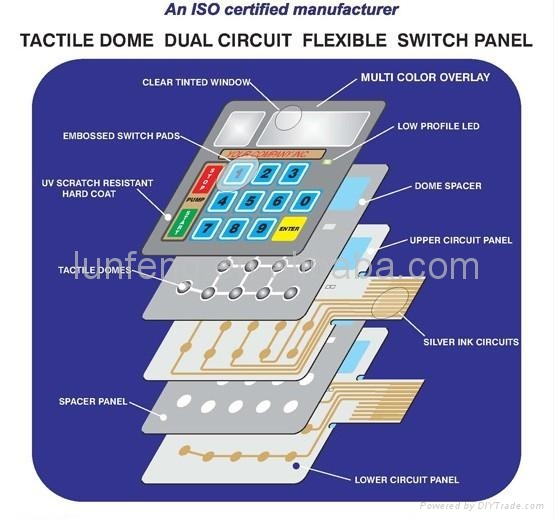Membrane Switch: A Comprehensive Guide to Its Uses and Applications
Membrane Switch: A Comprehensive Guide to Its Uses and Applications
Blog Article
Recognizing Membrane Switches Over: The Key to Trustworthy and durable Controls

What Are Membrane Layer Buttons?
Membrane switches are an advanced option in the world of interface technology, integrating performance and layout flawlessly. These devices serve as an interface in between individuals and digital systems, incorporating several elements right into a portable layout. Normally created from adaptable, thin layers of materials, membrane switches are developed to respond to touch, allowing individuals to engage with machinery and digital tools effectively.
The primary elements of a membrane layer switch include a printed circuit layer, graphic overlay, and a spacer layer that prevents unintended activation. The graphic overlay can be tailored to mirror brand name identity or user preferences, boosting aesthetic appeals while making sure functionality. Membrane buttons are generally used in different applications, including clinical gadgets, consumer electronic devices, and commercial devices, owing to their sturdiness and resistance to environmental variables such as dampness and dust.
One of the vital advantages of membrane buttons is their capability to stand up to wear and tear, making them optimal for high-traffic environments. In addition, they are light-weight and require marginal area, allowing for ingenious designs in item development. On the whole, membrane switches represent a practical and reliable option for modern-day electronic user interfaces, marrying modern technology with user-centric style concepts.
Exactly How Membrane Layer Switches Job
The procedure of membrane layer switches over joints on a simple yet reliable device that equates customer input into electronic signals. When an individual presses the button, the leading layer deforms, enabling a conductive aspect in the circuit layer to make call with a corresponding conductive pad on the underside of the graphic overlay.
The style of membrane layer buttons can vary, but they usually incorporate domes or tactile aspects to supply responses to the customer, boosting the overall experience - membrane switch. The materials used in membrane switches, such as polyester or polycarbonate, add to their sturdiness and resistance to ecological variables, including moisture and dust. The printed circuits are generally encapsulated, which secures them from wear and tear over time.
Benefits of Membrane Switches

Additionally, membrane switches are understood for their durability. Constructed from robust materials, they are immune to dirt, dampness, and physical wear, which significantly extends their life expectancy contrasted to typical mechanical buttons. This sturdiness makes them particularly ideal for high-traffic atmospheres and applications requiring durability.
An additional substantial benefit is the ease of cleaning and maintenance. The smooth surface area of membrane layer switches over decreases dirt buildup and is often unsusceptible spills, making them perfect for settings that call for constant sanitization.
Additionally, membrane layer switches offer a streamlined account, causing a thinner style that can be integrated right into numerous tools without adding bulk. This attribute not just improves the aesthetic allure yet likewise contributes to an extra ergonomic item style.
Applications of Membrane Buttons
User-friendly and functional, membrane switches locate applications across a vast array of sectors, consisting of medical gadgets, customer electronic devices, and industrial tools. In the medical field, these buttons are indispensable to tools such as diagnostic tools, individual monitoring systems, and mixture pumps, where reliability and convenience of cleaning are critical. Their capacity to endure rough atmospheres and maintain performance makes them perfect for such applications.

In Full Article customer electronic devices, membrane buttons are made use of in products like microwaves, washing equipments, and remote controls - membrane switch. Their smooth layout allows for instinctive interface, enhancing the general customer experience while providing longevity and resistance to tear and use
Commercial tools also gains from membrane layer buttons, particularly in control panels for machinery and automation systems. These switches use defense versus dust and moisture, making certain consistent performance in difficult settings. Their customizable features allow manufacturers to tailor them to particular operational needs, enhancing efficiency and functionality.
Choosing the Right Membrane Switch
When selecting a membrane switch, it is necessary to consider various factors that influence efficiency and viability for certain applications. The main considerations include ecological problems, responsive feedback, resilience, and design specifications.
First, analyze the operating setting; switches exposed to moisture, chemicals, or severe temperature levels need particular materials to ensure long life and performance. Next, assess the need for responsive responses. Depending upon user communication, some applications might gain from a tactile response to verify activation, while others might like a non-tactile style for aesthetic factors.
Sturdiness is another essential aspect; membrane buttons ought to be designed to hold up against regular use, influences, and abrasion. Make sure the selected button can withstand the expected lifecycle, especially in high-usage scenarios.

Conclusion
In conclusion, membrane switches over serve as other necessary components in the style of sturdy and reputable control systems throughout numerous industries. The flexibility of membrane layer switches over allows for tailored options that fulfill specific operational requirements, enhancing their value in modern technology.
Membrane layer changes stand for a crucial aspect of contemporary user interface style, mixing capability with resilience in various applications.Membrane buttons are Read Full Article an innovative solution in the realm of individual interface innovation, incorporating functionality and design effortlessly. Commonly constructed from versatile, slim layers of materials, membrane switches are created to react to touch, enabling users to communicate with machinery and electronic devices effectively.
The design of membrane layer buttons can differ, yet they usually include domes or responsive aspects to offer feedback to the user, enhancing the total experience.In verdict, membrane layer changes serve as essential components in the layout of trustworthy and long lasting control systems across various sectors.
Report this page